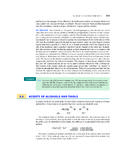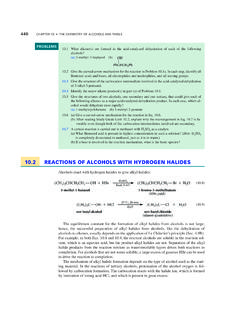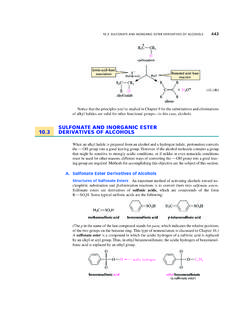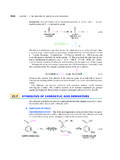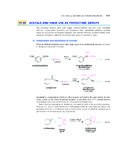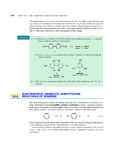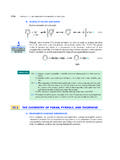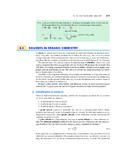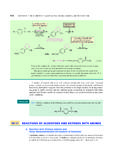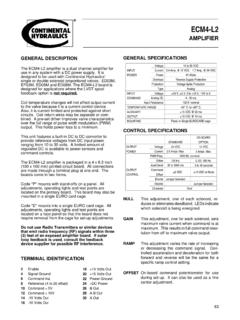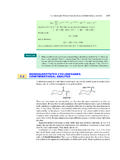Transcription of 3.5 FREE ENERGY AND CHEMICAL EQUILIBRIUM
1 106 CHAPTER 3 ACIDS AND BASES. THE CURVED-ARROW ENERGY AND CHEMICAL EQUILIBRIUMAs you learned in the previous section, the EQUILIBRIUM constant for a reaction tells us whichspecies in a CHEMICAL EQUILIBRIUM are present in highest concentrations. In this section, we regoing to examine the connection between the EQUILIBRIUM constant for a process and the rela-tive stabilitiesof the reactants and s start with a specific example the dissociation EQUILIBRIUM of hydrofluoric acid, a rel-atively weak acid:( )From Table , the pKaof HF is Hence, the dissociation constant Kaof HF is , 10_4. The small magnitude of this EQUILIBRIUM constant means that HF is dissociated toonly a small extent in aqueous solution. For example, in an aqueous solution containing MHF, a detailed calculation using the EQUILIBRIUM -constant expression shows that only about 8%of the acid is dissociated to fluoride ions and hydrated dissociation constant is related to the standard free - ENERGY differencebetween prod-ucts and reactants in the following way.
2 If Kais the dissociation constant as defined inEq. , then the standard free ENERGY of dissociationis defined by:DG a=-RTln Ka= Ka( )where ln indicates natural (base-e) logarithms, log indicates common (base-10) logarithms, Ris the molar gas constant ( K_1mol_1or 10_3kcal K_1mol_1), andTis the absolute temperature in kelvins (K). Because -log Kais by definition the pKa( ), then Eq. can be rewritten asDG a= (pKa)( )In terms of the HF ionization, the standard free ENERGY of dissociation DG ain Eq. isequal to the differencebetween the standard free energies of the ionization products (H3O|and F_) and the un-ionized acid (HF). The standard free ENERGY of the solvent (and referencebase) water, because it is the same for all acids, is arbitrarily set to zero (that is, ignored).Introducing the pKaof HF (= ) into Eq.
3 , we find, at 25 C (298 K), thatDG a= kJ mol_1( kcal mol_1)The meaning of this standard free - ENERGY change is that the products of the dissociationequilibrium, H3O|and F_, have kJ mol_1( kcal mol_1) more free ENERGY than theundissociated acid HF; that is, the products are less stablethan the reactants by kJ mol_1( kcal mol_1) under standard conditions, usually taken to be 1 atm pressure (for gases) or1 mole per liter for liquid solutions. Physically, this means that if we could somehow couple afree- ENERGY source, such as a battery, to the HF ionization reaction, this battery would have toprovide kJ ( kcal) of ENERGY to convert one mole per liter of HF completely into onemole per liter of hydrated protons and one mole per liter of fluoride ions. Or, we can turn theidea around: if we could somehow generate a solution containing one mole per liter of hy-drated protons and one mole per liter of fluoride ions, this solution would release mol_1 ( kcal mol_1) of free ENERGY if the two reacted completely to give water and onemole per liter of s now generalize this result for a reaction in which the starting material is Sand theproduct is P.
4 The EQUILIBRIUM constant Keqfor the interconversion of Sand Pis related to thestandard free - ENERGY difference (G P-G S) between Pand Sas follows:DG = G P-G S= log Keq( )F_H2OH3O|FH++ 12/8/08 11:53 AM Page free ENERGY AND CHEMICAL EQUILIBRIUM107 Rearranging, log Keq= ! !( )orKeq= 10_DG ( )Notice the exponential dependence of Keqon DG . This means that small changes in DG re-sult in large changes in Keq. Table shows this relationship numerically. This table shows thata change of kJ mol_1or kcal mol_1changes the EQUILIBRIUM constant Keqby one orderof magnitude. This free - ENERGY change has the same effect on the product:reactant ratios atequilibrium. In making conversions between EQUILIBRIUM constant and standard free ENERGY , the quantity appear frequently. At 25 C (298 K), equals kJ mol_1or kcal mol_1.
5 Theseare handy numbers to that DG is negative. This means that Shas a greater standard free ENERGY than P,or the product Pis more stablethan the starting material S. When Sand Pcome to EQUILIBRIUM ,Pwill be present in greater amount. This follows from Eq. : when DG is negative, theexponent is positive, and Keq>1. Suppose, on the other hand, that DG is positive. Thismeans that Shas a smaller standard free ENERGY than P that is, the product Pis less stablethan the starting material S. When Sand Pcome to EQUILIBRIUM , Swill be present in greateramount. Again, this follows from Eq. : when DG is positive, the exponent is negative,and Keq<1. This is the situation in the HLF ionization discussed earlier. The ionizationproducts of HF (H3O|and F_) are less stable than HF. Hence, the EQUILIBRIUM constant fortheir formation, Ka, is very small ( ).
6 The Relationship between Standard free - ENERGY Changes, EQUILIBRIUM Constants, and Relative EQUILIBRIUM Concentrations at 25 C (298 K)DG \ Keqor Keq\10_DG DG (kJ mol_1)(kJ mol_1)Keq[Products]3[reactants]+ + :1000000+ + :100000+ + :10000+ + :1000+ + :100+ + 1:1 :1 :1 :1 :1 :1 :1 TABLE 12/8/08 11:53 AM Page 107108 CHAPTER 3 ACIDS AND BASES. THE CURVED-ARROW NOTATIONLet s summarize the important points of this CHEMICAL EQUILIBRIUM favors the species of lower standard free The more two compounds differ in standard free ENERGY , the greater the difference intheir concentrations at EQUILIBRIUM . Each kJ mol_1( kcal mol_1) increment inDG affects the EQUILIBRIUM concentration ratio by a factor of follows from these two points that if we can analyze relative stabilities of molecules, we canthen predict EQUILIBRIUM constants by applying Eq.
7 Notice carefully the implication of thisstatement: Knowledge of molecular stabilities can lead to an understanding of CHEMICAL phe-nomena in this case, CHEMICAL EQUILIBRIUM . Molecular stabilities will form the basis for our un-derstanding of other CHEMICAL properties as well in particular, CHEMICAL reactivity. For this rea-son, we ll devote a lot of attention throughout this text to the relative stabilities of OF STRUCTURE TO ACIDITYThe goal of this section is to help you learn to use the structuresof compounds to predicttrends in their CHEMICAL properties. The CHEMICAL property we are going to deal with here isBr nsted acidity, but what you learn can be brought to bear on other CHEMICAL properties. Thissection will answer the following question: How can we predict the relative strengths of Br n-sted acids within a series?
8 Your ability to deal with questions like this will require that you useall that you have learned in the previous The Element EffectOne of the most important things that determines the acidity of a Br nsted acid is the identityof the atom to which the acidic hydrogen is attached. For example, consider the acidities of thefollowing two compounds:CH3CH2 OHLL ethanol(an alcohol)pKa = (a thiol, or mercaptan)pKa = (a)A reaction has a standard free - ENERGY change of kJ mol-1( kcal mol-1).Calculate the EQUILIBRIUM constant for the reaction at 25 C.(b) Calculate the standard free - ENERGY difference between starting materials and products fora reaction that has an EQUILIBRIUM constant of (a)AreactionA+BQChas a standard free - ENERGY change kJ mol-1( kcal mol-1)at25 C. What are the concentrations ofA,B,andCatequilibriumif, atthe beginning of the reaction, their concentrations are , ,and0M,respectively?
9 (b) Without making a calculation, tell in a qualitative sense how you would expect your an-swer for part (a) to change if the reaction has instead a standard free - ENERGY change of+ kJ mol-1(+ kcal mol-1). Complete each of the following statements with a number. Assume that the temperature is25 C (298 K).(a) Two reactions have EQUILIBRIUM constants that differ by a factor of 10. Their standard freeenergies differ by _____ kJ mol-1.(b)For every 1 kJ mol-1in standard free ENERGY that two reactions differ, their equilibriumconstants differ by a factor of 12/8/08 11:53 AM Page 108
